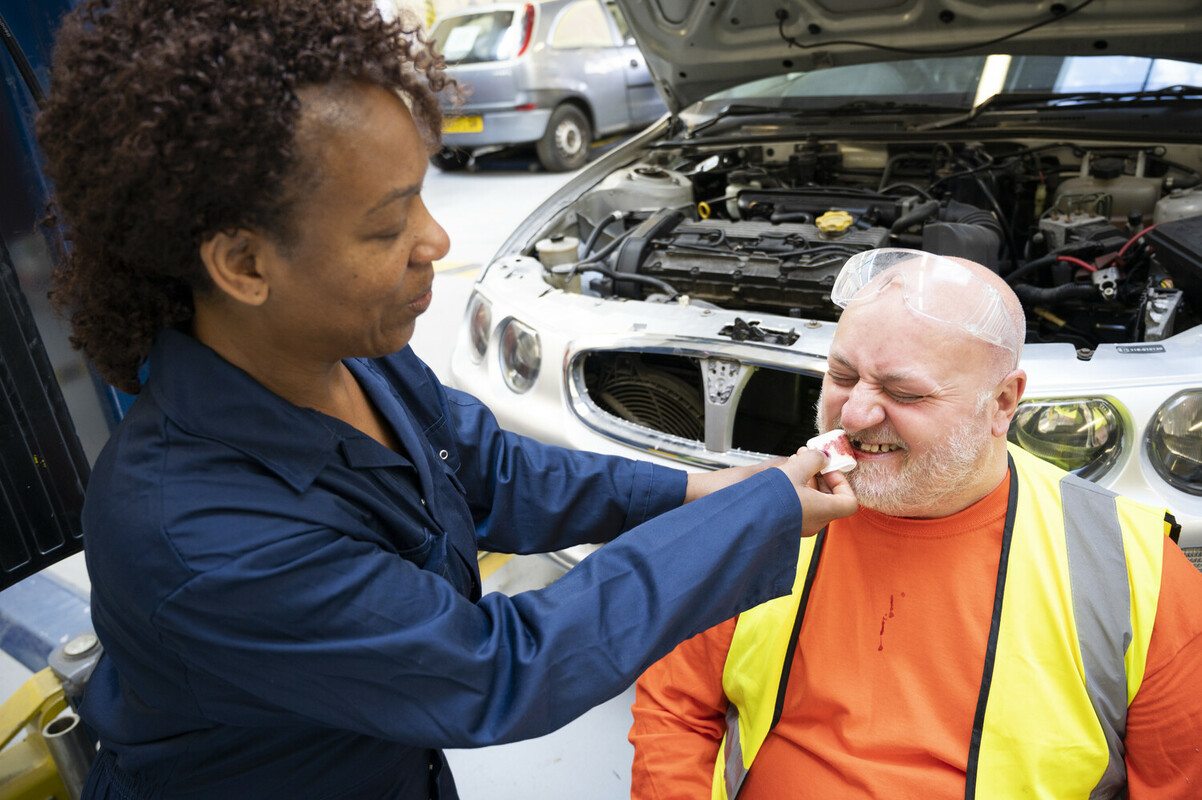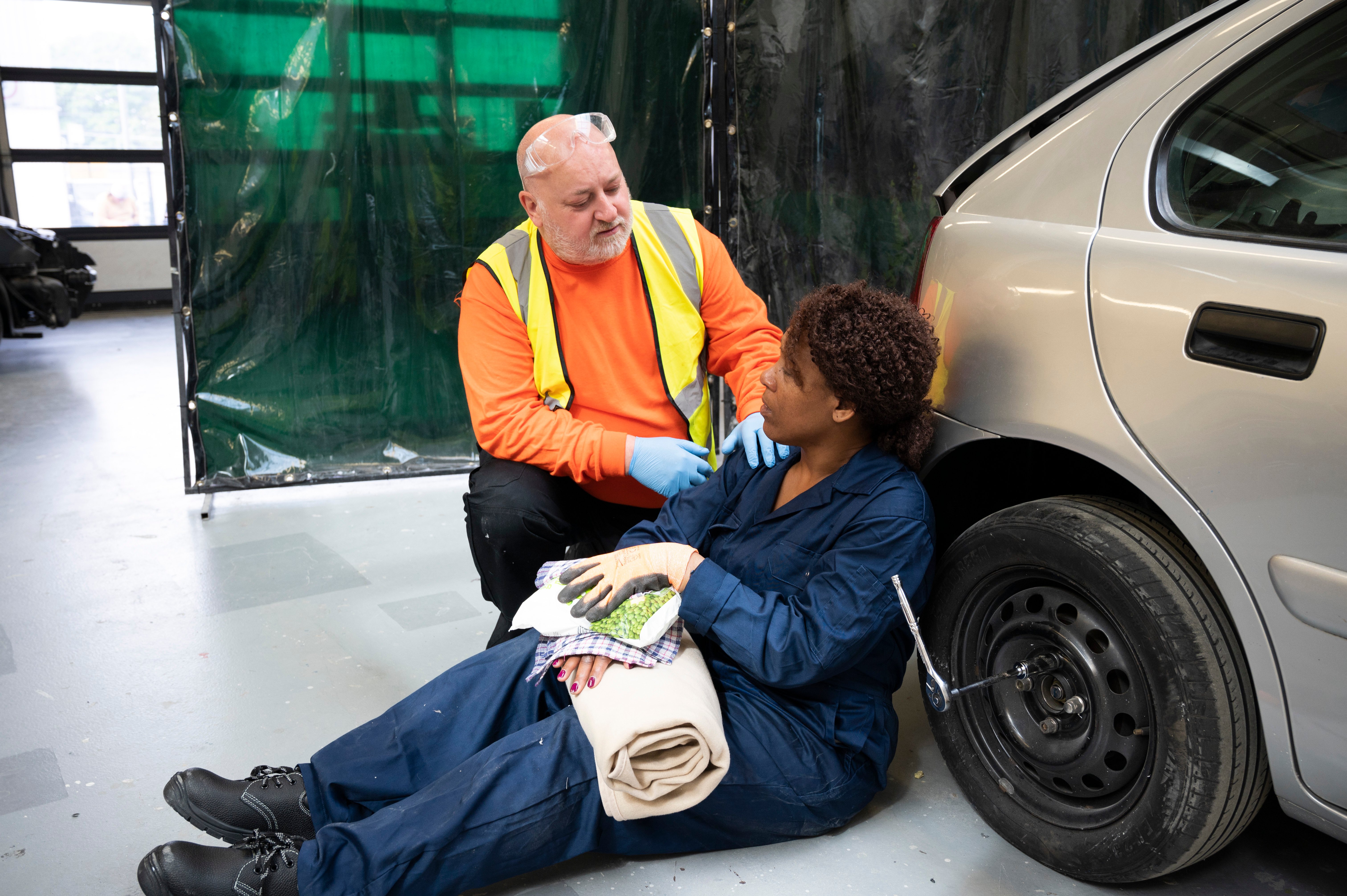First aiders have a range of responsibilities. In emergency situations, they need to be able to offer appropriate care to anyone who is ill or has suffered an injury. They also have other tasks, such as making sure their first aid training is up-to-date and understanding the risks and hazards applicable to their workplace.
Finally, they have certain legal responsibilities and protections when giving first aid. In this blog, we examine the different duties of a first aider and help you learn how to fulfil them.
What is a first aider?
A first aider is someone who has been trained to provide basic medical care to someone who is injured or ill. They are not doctors, but they have the knowledge and skills to help someone until medical help is available.
Qualified first aiders have normally undergone one of two types of training. These are:
1. Emergency First Aid at Work (EFAW)
This is Level 2 first aid training designed for people who are designated as first aiders in lower-risk workplaces. Courses typically cover a range of topics, including CPR (cardiopulmonary resuscitation), dealing with bleeding and wounds, managing choking incidents, aiding with minor injuries and understanding the appropriate actions to take in an emergency situation. EFAW training usually lasts for one day and a certificate is issued when the course is successfully completed; the certification is valid for three years.
2. First Aid at Work (FAW)
This is a Level 3 course offering comprehensive and in-depth training for designated first aiders in higher-risk workplaces. FAW training covers a wider range of topics, including how to help a casualty who is having a seizure, heart attack, diabetic emergency or a severe allergic reaction. FAW training typically spans three days and is valid for three years.
First aiders can also undertake specialist training, such as paediatric first aid. In some cases, the Health and Safety (First-aid) Regulations 1981 do not require certain smaller employers to appoint a first aider. In these cases, there needs to be an ‘appointed person’ responsible for first aid. They do not need to have undertaken first aid training, although some choose to take a first aid for appointed persons course.
Want to fulfil your first aid obligations but don't know where to begin?
Use our course finder tool and discover which first aid training your business will ensure your team are compliant and safe while at work.
What are the key responsibilities of a first aider?
The main duty of a first aider is to provide immediate medical assistance to someone who is injured, sick or experiencing a medical emergency.
The extent of your treatment you provide will depend on the seriousness of the person’s injury/medical complaint. For example, you may be required to provide support for something as simple as the safe removal of a splinter.
However, in more serious circumstances, you will need to:
- Assess the situation. It is important to evaluate the situation quickly and make sure it is safe for both you and the person who is injured or ill. If there are any hazards present at the scene, you need to take steps to remove them or minimise their risk before you assist the casualty.
- Provide initial care. Administer appropriate first aid to stabilise the person’s condition and prevent further harm. This may involve performing CPR, controlling bleeding, dealing with choking or addressing other immediate medical needs. You should only use techniques you have been trained in, otherwise you could cause further harm.
- Get professional help. If necessary, you should call the emergency services or instruct someone else to do so. This is particularly important in cases of severe injury, medical emergencies, or when specialised medical attention is required. If you are dealing with a minor injury, it may be more appropriate to call NHS 111 for advice or refer the casualty to their GP.
- Communicate with the injured person and others. It is important to stay calm and communicate clearly while at the scene. Introduce yourself to the casualty if they are conscious and explain what you are going to do before you do it. If other people are at the scene, tell them exactly how they can help (such as by calling an ambulance or leaving the scene to maintain the casualty’s dignity and privacy).
- Monitor the injured person. Always keep a close watch on the casualty. Monitor vital signs such as their breathing rate, pulse rate, and body temperature. If a person becomes unconscious, make sure their airway is clear and that they are breathing. If needed, start CPR.
- Keep records of the incident. This includes things like the date, time, and location of the incident, the casualty's injuries, and the first aid treatment that was provided. Documents such as accident forms provide evidence of the care provided and may be required for legal purposes. They can also be valuable for the ongoing review and improvement of first aid procedures. It is important to consider data protection when keeping a record of incidents.

Duties of a first aider extend beyond administering help to sick or injured people. These include:
- Keeping your first aid skills up to date. If you have successfully completed Emergency First Aid at Work (EFAW) or First Aid at Work training, you will get a certificate that is valid for three years. After that time, you will need to do the course again. That said, it is a good idea to participate in a half-day first aid annual skills update course, either in person or online. It is important to note that as the designated first aider, you will not necessarily always be responsible for keeping the training records up to date; in some businesses, this falls under the remit of a dedicated team or person who manages learning and development or health and safety training.
- Being aware of risks and hazards in your workplace. If you are aware of specific risks and hazards in the working environment, you may be able to help inform the needs assessment or may want to request more training if you do not feel the training you have received is sufficient for the hazards you have experienced. If your employer has a written first aid needs assessment, familiarise yourself with its contents.
- Being familiar with first aid equipment. You should make sure that you know where to find equipment such as first-aid boxes and AEDs (defibrillators). If you do not know how to use certain equipment, make sure you get appropriate training.
NB: Regardless of the training in which you participate, it is essential for first aiders to only work within the limits of the training they have received.
Can I be sued for doing first aid?
It is highly unlikely that you will be sued for doing first aid. If you provide first aid in good faith, you also have a level of legal protection within the United Kingdom.
The Social Action, Responsibility, and Heroism (SARAH) Act 2015 was introduced In England and Wales to provide legal safeguards for individuals who give reasonable assistance to an ill or injured person.
This legislation gives guidance to courts that any allegations of negligence should take into account whether the person was acting for the benefit of society, took a responsible approach or acted heroically in an emergency situation.
That said, if your actions as a first aider are deemed negligent, reckless, or outside the scope of your training and competence, it is possible you could face legal consequences. To minimise any potential liability, we recommend that you:
- Use only first aid techniques that you are trained in.
- Always seek professional medical help when necessary.
- Document the care you have given accurately and thoroughly.
- Ensure your first aid training is up-to-date and take regular refresher courses.
While we cannot advise on legal issues, the bottom line is that if you act in good faith to help to save someone's life or prevent further injury, there is very little risk of being successfully sued.
Train your team with a name you can trust
Use our course finder tool and discover which first aid at work training course will ensure your business is compliant.
Can I complete the duties of a first aider without training?
If an emergency occurs in the workplace, it is best if a trained first aider takes responsibility for it. If giving first aid is something that can be reasonably expected, your employer should arrange training for an adequate number of first aiders (see our blog post on how many first aiders are required for a workplace).
In situations where no first aider is available, you can still help within the limitations of your own skills, if you are comfortable doing so. If necessary, call 999 to summon the emergency services or dial the NHS 111 service to ask for help.
Maintaining first aid skills within your team
First aiders have a wide range of practical, ethical, and legal responsibilities. However, the core responsibility for them is being able to provide appropriate and effective first aid to ill or injured people.
The key to doing this as competently as possible is to make sure you've the right level of first aid training. It is also wise to take regular refresher courses, such as an annual skills update.
First aid skills are easy to acquire, rewarding to learn, and can save lives. Enrol suitable members of your team, or others, on a British Red Cross training course today, and improve their first aid abilities.
Topics: First Aid





